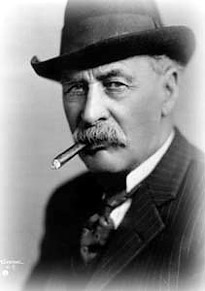'There It Is -- Take It!'

After bouncing around as a merchant seaman, lumberjack, miner and injun-fighter, William Mulholland (born on this day in 1855 in Belfast) found his destiny in 1878 in a shack near a beloved old sycamore tree within spitting distance of Los Feliz and Riverside Drive in Los Angeles, digging ditches for the local private water company. A self-taught hydraulic engineer, Mulholland learned the manner in which the small pueblo assiduously, if primitively, managed its limited water resources with a byzantine system of ditches and clay pipes; but he was one of the first to realize, after the drought of the 1890s, that Los Angeles would always remain a small pueblo without a new water supply.
As superintendent of L.A.'s newly-created DWP in 1904, Mulholland and ex-mayor Fred Eaton rode north to the green and fertile Owens Valley, nestled at 4,000 feet amid the Sierra Nevadas and the White Mountains. Mulholland's secret scheme was to dam the Owens River and create an aqueduct which could carry water for a million people down to L.A. without pumps or power. Mulholland and Eaton quietly bought land and water rights from the local irrigation farmers and ranchers, and what they couldn't buy, they snatched away through bribes and undue influence, foiling the plans of the local business boosters to establish their own water district. With the deeds in his pocket, Mulholland succeeded in convincing President Theodore Roosevelt to help clear the path of his proposed aqueduct through federal land.
It took Mulholland 6 years with 5,000 workers to complete the 233-mile aqueduct -- the longest in the world -- and on November 5, 1913, thousands gathered to watch the Owens Valley water roar into the San Fernando Valley. "There it is!," Mulholland said, addressing the crowd, "Take it!"
As Los Angeles grew, and the Owens Valley itself became economically extinct, Mulholland was hailed as a hero, until March 12, 1928, when his St. Francis Dam on the Santa Clara River collapsed, causing a flood that killed 450 people. Mulholland took the blame for the tragedy (although in 1992, an association of engineers posthumously exonerated him), and he stepped down from the leadership of the DWP, living an increasingly reclusive life until he passed away at 80, on July 22, 1935 in Los Angeles, California.
For all those who see the growth of L.A. as an uncontrolled plague and long for the innocent California of yore, Mulholland's great water grab was certainly a sinister achievement, and the fictional murder of a character loosely based on him in Roman Polanski's Chinatown (1974) stands as poetic revenge.
Labels: Southern California, Water





0 Comments:
Post a Comment
Subscribe to Post Comments [Atom]
<< Home